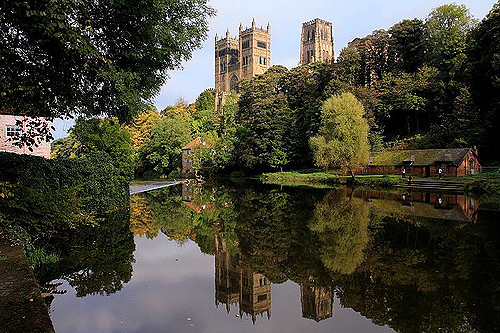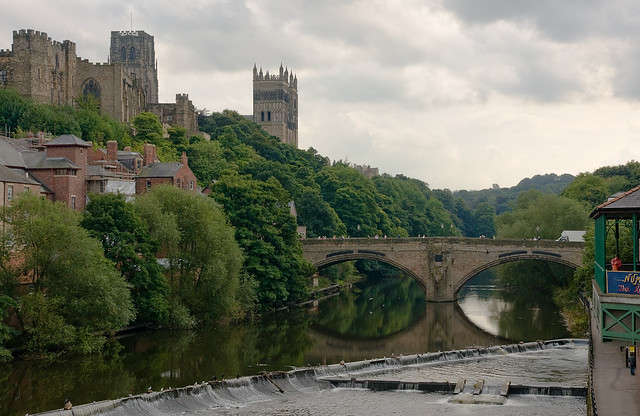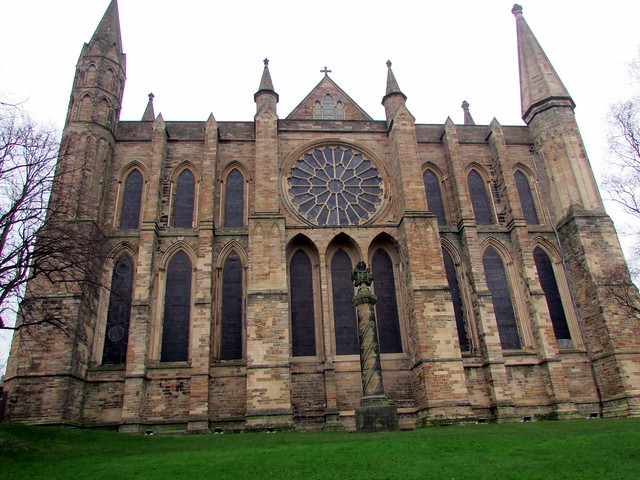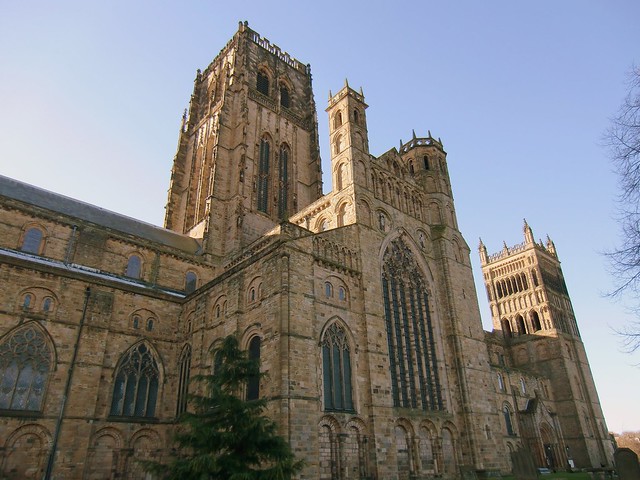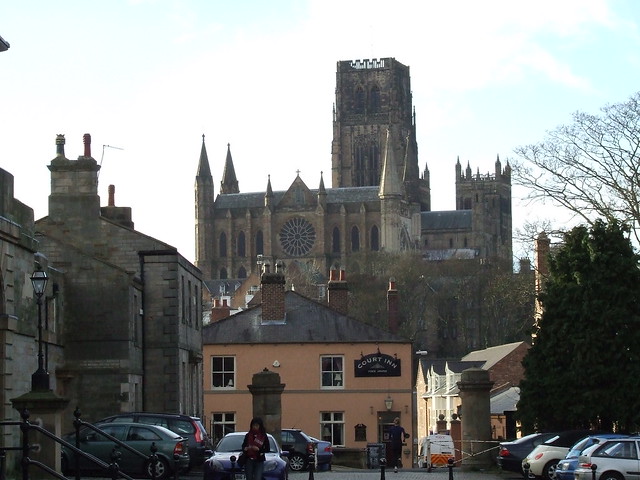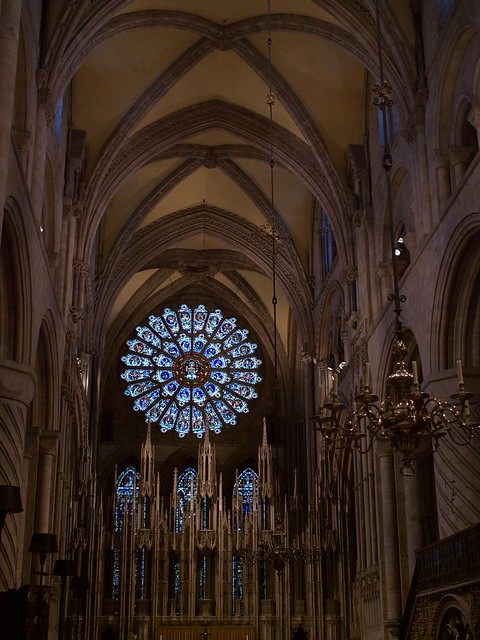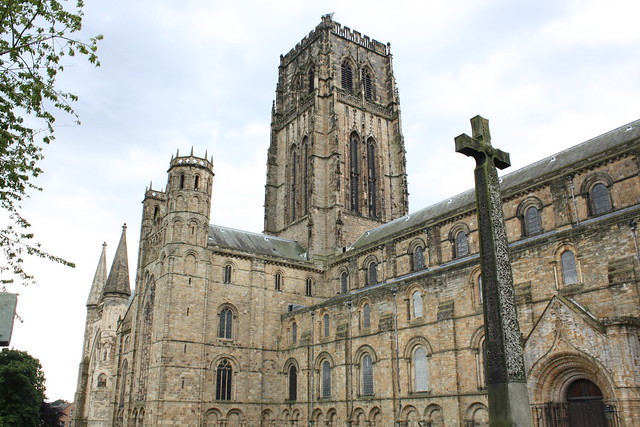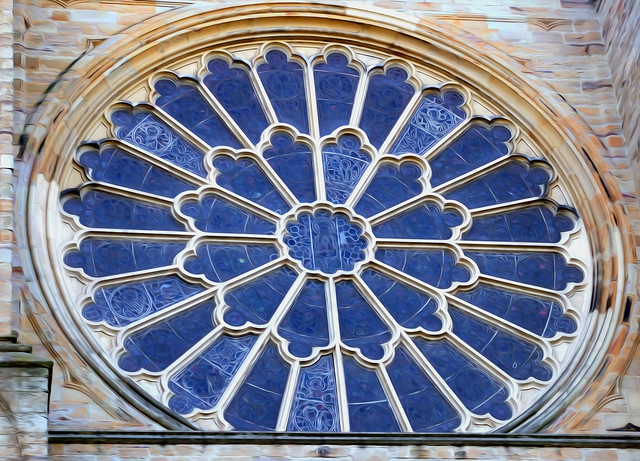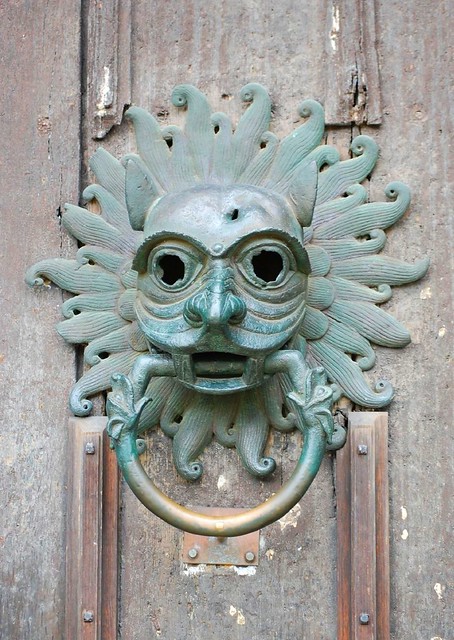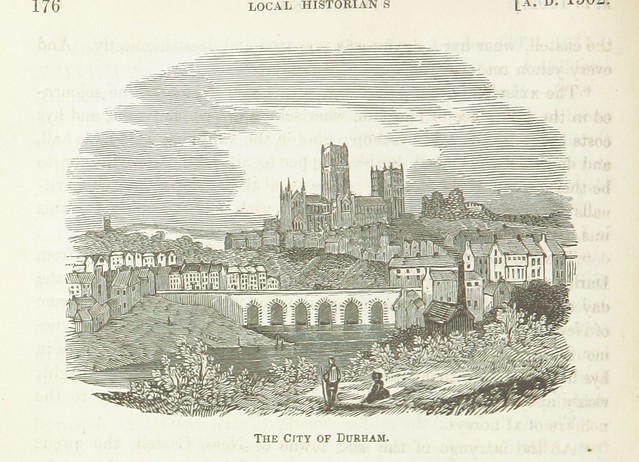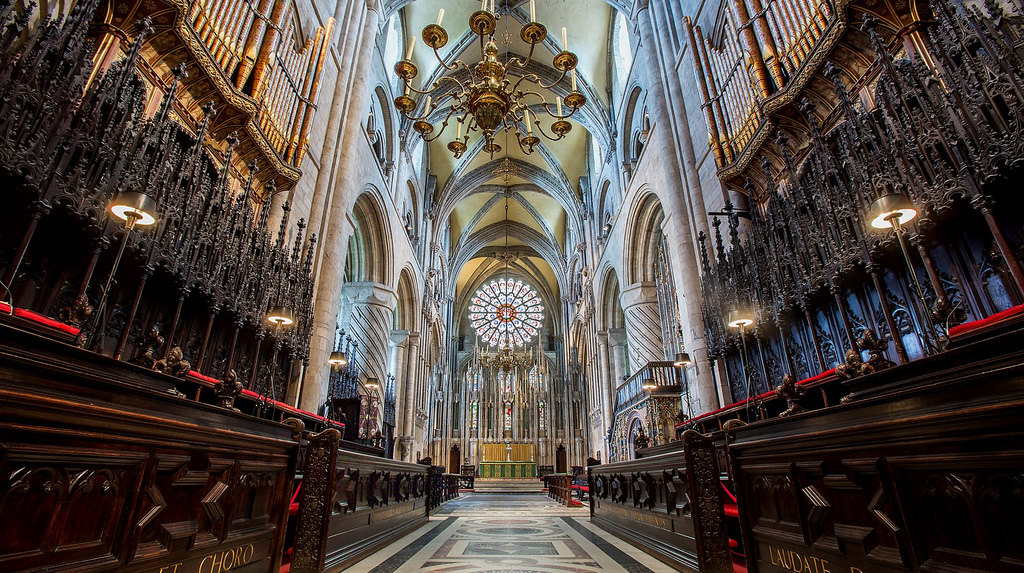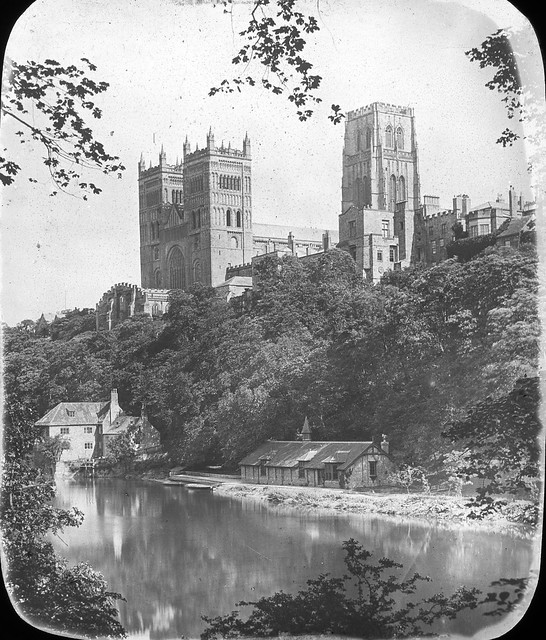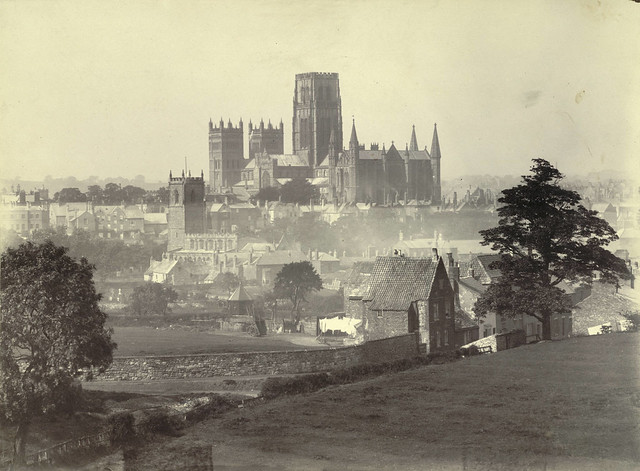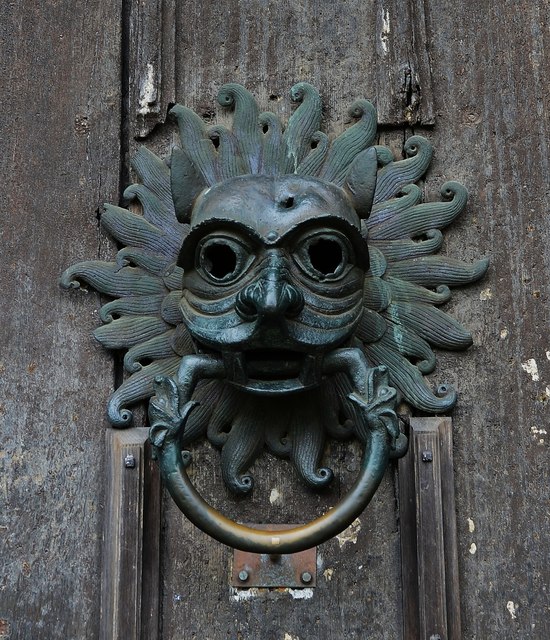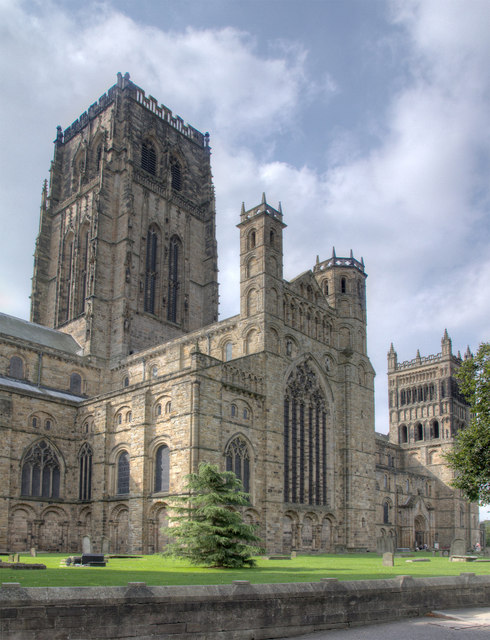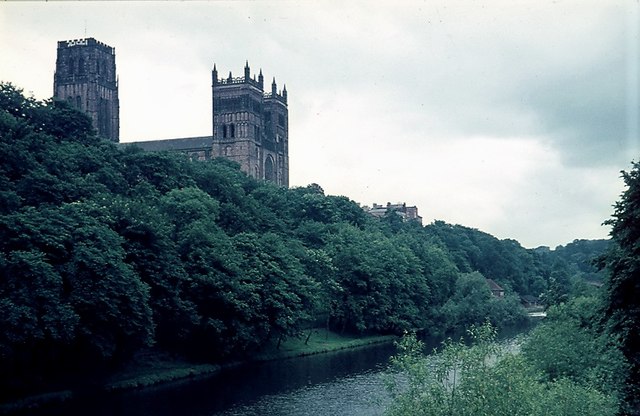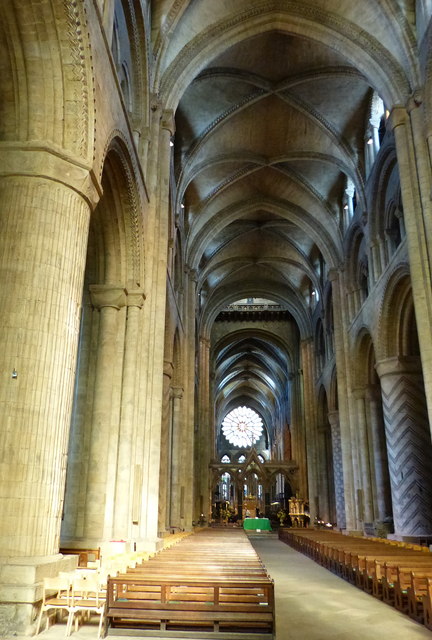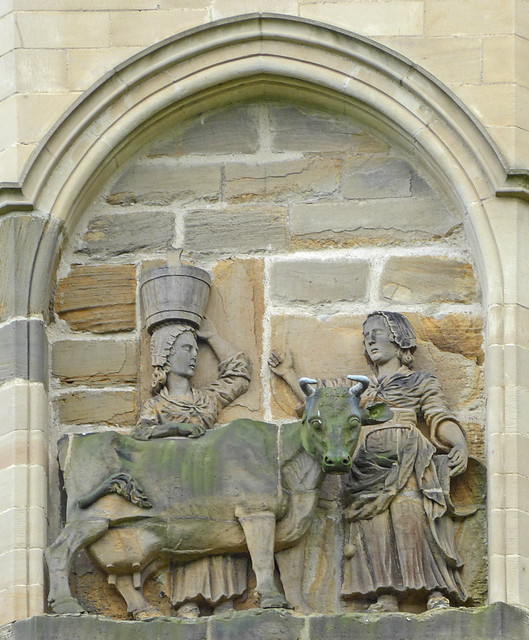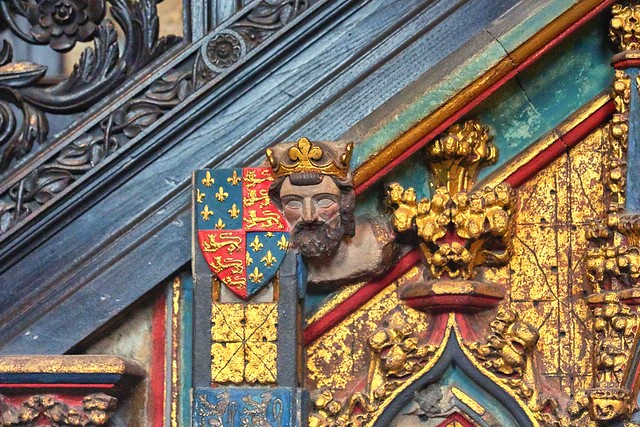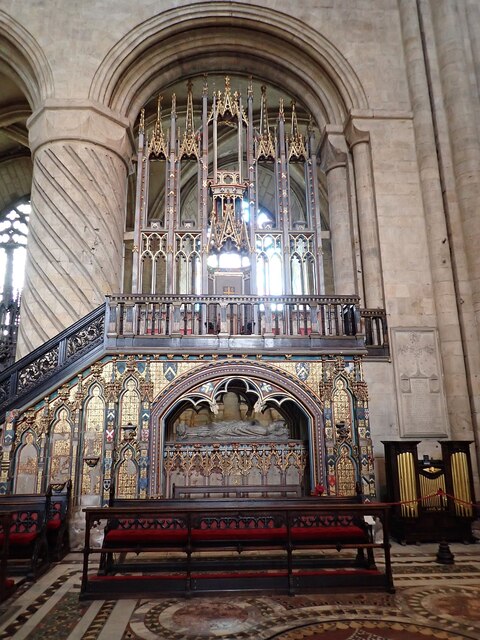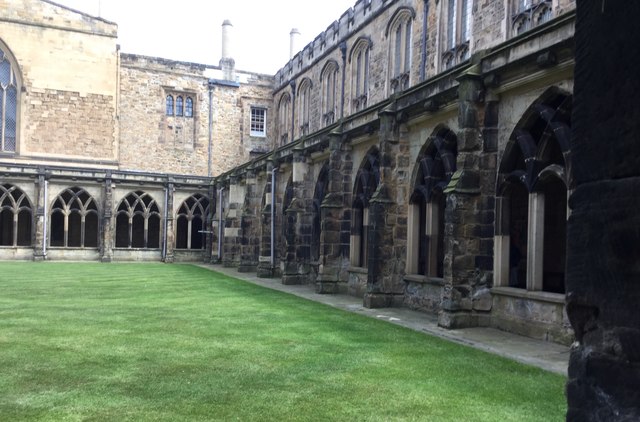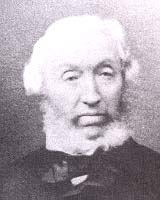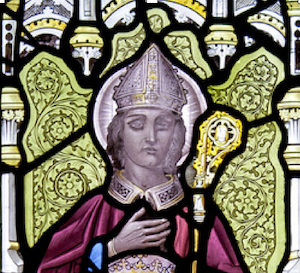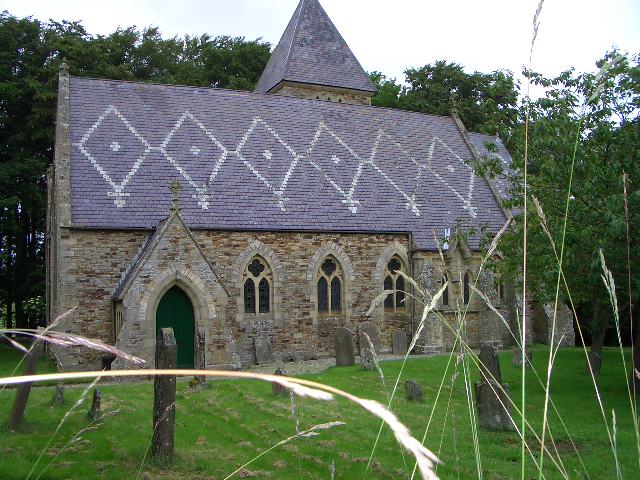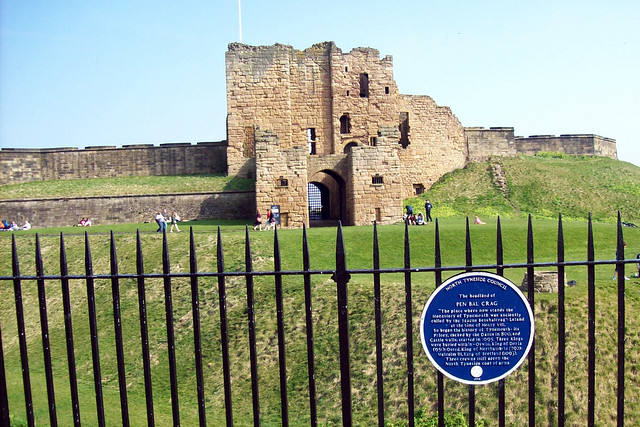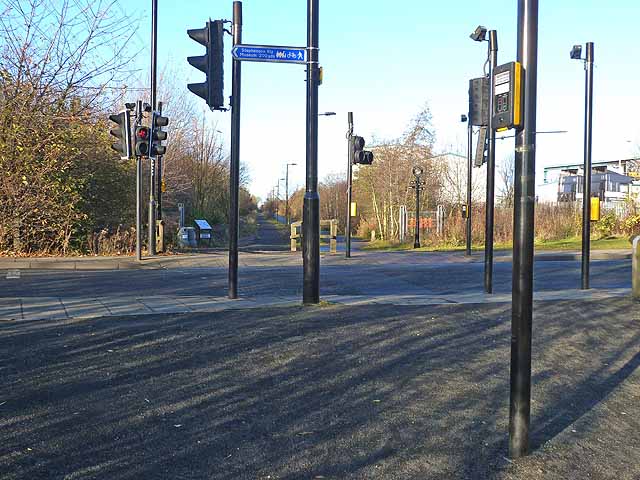Topics > County Durham > Durham (City) > Durham Cathedral
Durham Cathedral
The Cathedral Church of Christ, Blessed Mary the Virgin and St Cuthbert of Durham, usually known as Durham Cathedral and home of the Shrine of St Cuthbert, is a cathedral in the city of Durham, England, the seat of the Anglican Bishop of Durham. The bishopric dates from 995, with the present cathedral being founded in AD 1093. The cathedral is regarded as one of the finest examples of Norman architecture and has been designated a UNESCO World Heritage Site along with nearby Durham Castle, which faces it across Palace Green.
The present cathedral replaced the 10th century "White Church", built as part of a monastic foundation to house the shrine of Saint Cuthbert of Lindisfarne. The treasures of Durham Cathedral include relics of St Cuthbert, the head of St Oswald of Northumbria and the remains of the Venerable Bede. In addition, its Library contains one of the most complete sets of early printed books in England, the pre-Dissolution monastic accounts, and three copies of the Magna Carta.
Durham Cathedral occupies a strategic position on a promontory high above the River Wear. From 1080 until the 19th century the bishopric enjoyed the powers of a Bishop Palatine, having military as well as religious leadership and power. Durham Castle was built as the residence for the Bishop of Durham. The seat of the Bishop of Durham is the fourth most significant in the Church of England hierarchy, and he stands at the right hand of the monarch at coronations. Signposts for the modern day County Durham are subtitled "Land of the Prince Bishops."
There are daily Church of England services at the cathedral, with the Durham Cathedral Choir singing daily except Mondays and when the choir is on holiday. The cathedral is a major tourist attraction within the region, the central tower of 217 feet (66 m) giving views of Durham and the surrounding area.
Visit the page: Durham Cathedral for references and further details. You can contribute to this article on Wikipedia.
Saxon
The see of Durham takes its origins from the Diocese of Lindisfarne, founded by Saint Aidan at the behest of Oswald of Northumbria around AD 635. The see lasted until AD 664, at which point it was translated to York. The see was then reinstated at Lindisfarne in AD 678 by the Archbishop of Canterbury. Among the many saints produced in the community at Lindisfarne Priory, Saint Cuthbert, who was Bishop of Lindisfarne from AD 685 until his death on Farne Island in 687, is central to the development of Durham Cathedral.
After repeated Viking raids, the monks fled Lindisfarne in AD 875, carrying St Cuthbert's relics with them. The diocese of Lindisfarne remained itinerant until 882, when a community was re-established in Chester-le-Street. The see had its seat here until AD 995, when further incursions once again caused the monks to move with the relics. According to local legend, the monks followed two milk maids who were searching for a dun (i.e. brown) cow and were led into a peninsula formed by a loop in the River Wear. At this point Cuthbert's coffin became immovable. This trope of hagiography was offered for a sign that the new shrine should be built here. A more prosaic set of reasons for the selection of the peninsula is its highly defensible position, and that a community established here would enjoy the protection of the Earl of Northumberland, as the bishop at this time, Aldhun, had strong family links with the earls. Nevertheless, the street leading from The Bailey past the Cathedral's eastern towers up to Palace Green is named Dun Cow Lane due to the miniature(dun) cows that used to graze in the pastures nearby.
Initially, a very simple temporary structure was built from local timber to house the relics of Cuthbert. The shrine was then transferred to a sturdier, probably wooden, building known as the White Church. This church was itself replaced three years later in 998 by a stone building also known as the White Church, which was complete apart from its tower by 1018. Durham soon became a site of pilgrimage, encouraged by the growing cult of Saint Cuthbert. King Canute was one early pilgrim, granting many privileges and much land to the Durham community. The defendable position, flow of money from pilgrims and power embodied in the church at Durham ensured that a town formed around the cathedral, establishing the early core of the modern city.
Norman
The present cathedral was designed and built under William of St. Carilef (or William of Calais) who was appointed as the first prince-bishop by William the Conqueror in 1080. Since that time, there have been major additions and reconstructions of some parts of the building, but the greater part of the structure remains true to the Norman design. Construction of the cathedral began in 1093 at the eastern end. The choir was completed by 1096 and work proceeded on the nave of which the walls were finished by 1128, and the high vault complete by 1135. The chapter house, partially demolished in the 18th century, was built between 1133 and 1140. William died in 1099 before the building's completion, passing responsibility to his successor, Ranulf Flambard, who also built Flamwell Bridge, the first crossing of the River Wear in the town. Three bishops, William of St. Carilef, Ranulf Flambard and Hugh de Puiset, are all buried in the rebuilt chapter house.
In the 1170s, Bishop de Puiset, after a false start at the eastern end where the subsidence and cracking prevented work from continuing, added the Galilee Chapel at the west end of the cathedral. The five-aisled building occupies the position of a porch, it functioned as a Lady chapel and the great west door was blocked during the Medieval period by an altar to the Virgin Mary. The door is now blocked by the tomb of Bishop Langley. The Galilee Chapel also holds the remains of the Venerable Bede. The main entrance to the cathedral is on the northern side, facing towards the castle.
In 1228 Richard le Poore came from Salisbury where a new cathedral was being built in the Gothic style. At this time, the eastern end of the cathedral was in urgent need of repair and the proposed eastern extension had failed. Richard le Poore employed the architect Richard Farnham to design an eastern terminal for the building in which many monks could say the Daily Office simultaneously. The resulting building was the Chapel of the Nine Altars. The towers also date from the early 13th century, but the central tower was damaged by lightning and replaced in two stages in the 15th century, the master masons being Thomas Barton and John Bell.
The Shrine of St Cuthbert was located in the eastern apsidal end of the cathedral. The location of the inner wall of the apse is marked on the pavement and St Cuthbert's tomb is covered by a simple slab. However, an unknown monk wrote in 1593:
Dissolution
Cuthbert's tomb was destroyed on the orders of Henry VIII in 1538, and the monastery's wealth handed over to the king. The body of the saint was exhumed, and according to the Rites of Durham, was discovered to be uncorrupted. It was reburied under a plain stone slab worn by the knees of pilgrims, but the ancient paving around it remains intact. Two years later, on 31 December 1540, the Benedictine monastery at Durham was dissolved, and the last prior of Durham – Hugh Whitehead—became the first dean of the cathedral's secular chapter.
17th century
After the Battle of Dunbar on 3 September 1650, Durham Cathedral was used by Oliver Cromwell as a makeshift prison to hold Scottish prisoners-of-war. It is estimated that as many as 3,000 were imprisoned of whom 1,700 died in the cathedral itself, where they were kept in inhumane conditions, largely without food, water or heat. The prisoners destroyed much of the cathedral woodwork for firewood but Prior Castell's Clock, which featured the Scottish thistle, was spared. It is reputed that the prisoners' bodies were buried in unmarked graves. The survivors were shipped as slave labour to North America.
In 1946 during work to install a new central heating system for the University, a mass grave of the Scottish soldiers was allegedly uncovered. Towards the end of 2007 a campaign was launched to commemorate the Dunbar Martyrs. Further to this and with the agreement of Durham University, Historic Scotland funded a geophysical survey of Palace Green. It was hoped that this might provide clarity on the final resting place of the dead, but results were inconclusive. During 2010 the cathedral chapter agreed to the installation of a memorial plaque within St Margaret of Scotland's chapel at the cathedral. The "Dunbar Martyr" campaigners are raising funds to assist with the cost of creation and installation of the plaque, which will bear a Scots Thistle.
Bishop John Cosin, who had previously been a canon of the cathedral, set about restoring the damage and refurnishing the building with new stalls, the litany desk and the towering canopy over the font. An oak screen to carry the organ was added at this time to replace a stone screen pulled down in the 16th century. On the remains of the old refectory, the Dean, John Sudbury founded a library of early printed books.
1700–1900
During the 18th century, the deans of Durham often held another position in the south of England, and after spending the statutory time in residence, would depart to manage their affairs. Consequently, after Cosin's refurbishment, there was little by way of restoration or rebuilding. When work commenced again on the building, it was of a most unsympathetic nature. In 1773 the architect George Nicholson, having completed the Prebend's Bridge across the Wear, persuaded the dean and chapter to let him smooth off much of the outer stonework of the cathedral, thereby considerably altering its character.
The architect James Wyatt greatly added to the destruction by demolishing half the Chapter House, altering the stonework of the east end, and inserting a large rose window that was supposed to be faithful to one that had been there in the 13th century. Wyatt also planned to demolish the Galilee Chapel, but the Dean, John Cornwallis, returned and prevented it, just as the lead was being stripped from the roof.
The restoration of the cathedral's tower between 1854 and 1859 was by the architect Sir George Gilbert Scott, working with Edward Robert Robson, who went on to serve as architect in charge of the cathedral for six years. In 1858 Anthony Salvin restored the cloisters.
20th century
In 1986, the cathedral, together with the nearby Castle, became a World Heritage Site. The UNESCO committee classified the cathedral under criteria C (ii) (iv) (vi), reporting, "Durham Cathedral is the largest and most perfect monument of 'Norman' style architecture in England".
In 1996, the Great Western Doorway was the setting for Bill Viola's large-scale video installation The Messenger.
Interior views of the cathedral were featured in the 1998 film Elizabeth.
21st century
Durham Cathedral has been featured in the Harry Potter films as Hogwarts School of Witchcraft and Wizardry, where it had a spire digitally added onto the top of the famous towers. It is also featured in Season 5's last episode of Inspector George Gently.
Architectural historian Dan Cruickshank selected the cathedral as one of his four choices for the 2002 BBC television documentary series Britain's Best Buildings.
In November 2009 the cathedral featured in the Lumiere festival whose highlight was the "Crown of Light" illumination of the North Front of the cathedral with a 15-minute presentation that told the story of Lindisfarne and the foundation of cathedral, using illustrations and text from the Lindisfarne Gospels. The Lumiere festival was repeated in 2011, 2013 and 2015.
Visit the page: Durham Cathedral for references and further details. You can contribute to this article on Wikipedia.
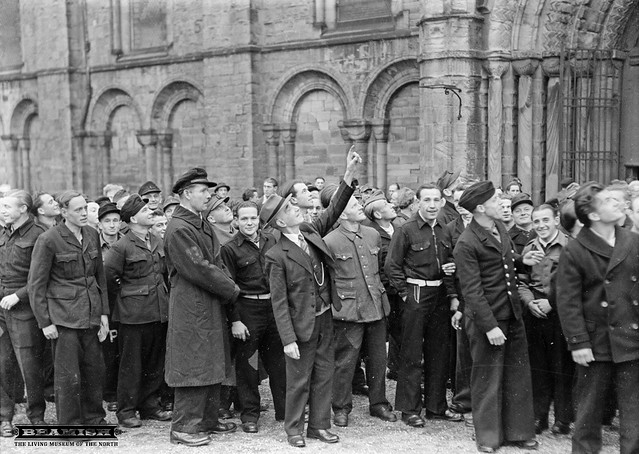
from Beamish (flickr)
German POWs being shown around Durham Cathedral, 1946
Pinned by Simon Cotterill
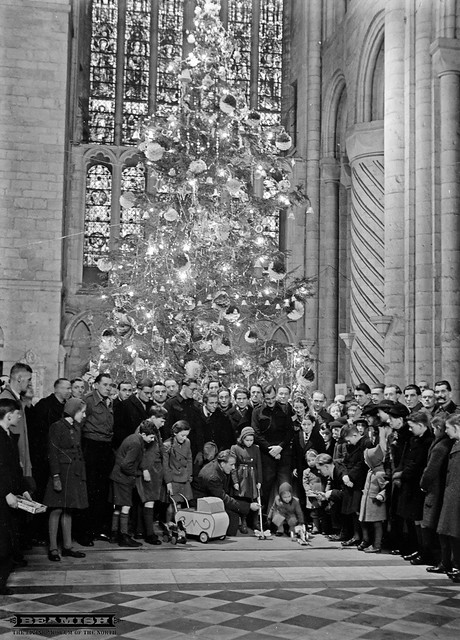
from Beamish (flickr)
German POWs giving presents at Durham Cathedral, 1946
Pinned by Simon Cotterill
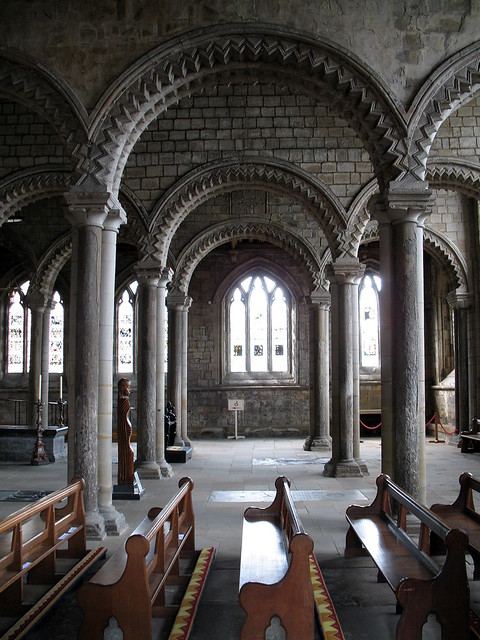
from Flickr (flickr)
The Galilee Chapel, Durham Cathedral, Durham, England
Pinned by Simon Cotterill
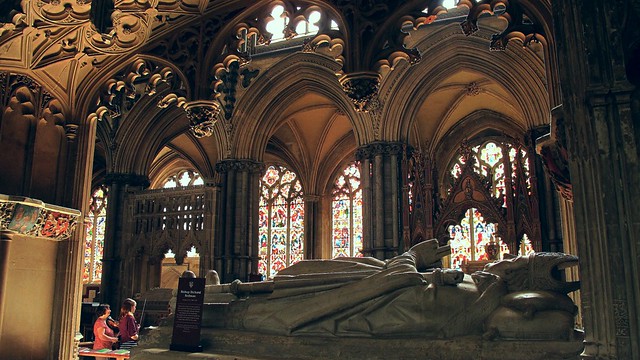
from Flickr (flickr)
The Tomb of Bishop Richard Redman in Durham Cathedral
Pinned by Simon Cotterill

from Youtube (youtube)
Durham Cathedral: Readers choice for Britain's best building
Pinned by Simon Cotterill
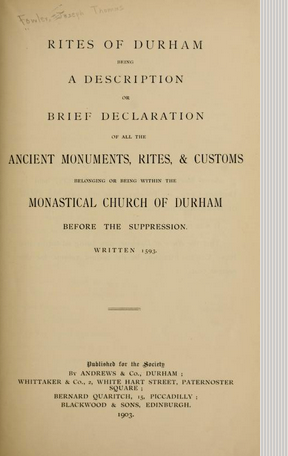
from https://archive.org/details/r…
Rites of Durham, being a description or brief declaration of all the ancient monuments, rites, & customs belonging or being within the monastical church of Durham before the suppression
- A book written the first half of the sixteenth century giving a detailed account of Durham Cathedral as a Catholic institution, before the Reformation and its conversion to an Anglican …
Added by
Simon Cotterill
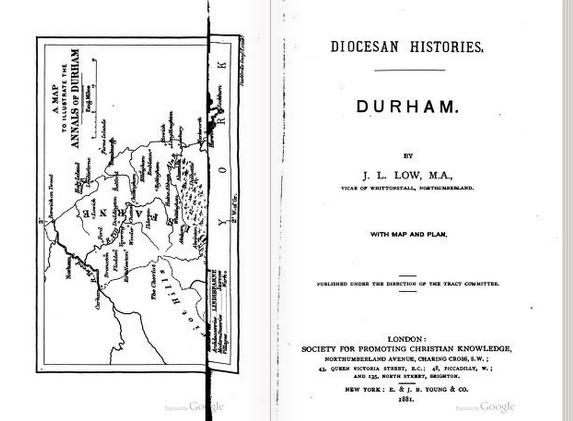
from https://archive.org/details/d…
Durham - Diocesan Histories
- by John Low, 1817-1888. Society for promoting Christian knowledge, London. Tract committee. Published 1881. Available as a free eBook.
Added by
Simon Cotterill
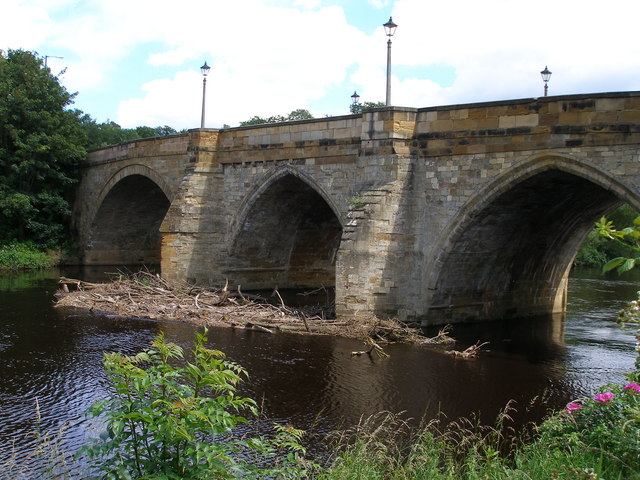
Co-Curate Page
Walter Skirlaw (d. 1406)
- Overview About Walter Skirlaw Walter Skirlaw was Bishop of Durham from 1388 until he died on 24th March 1406. Skirlaw was also a diplomat and advisor to King Richard II …

from Flickr (flickr)
Image taken from page 18 of 'A brief Sketch of Durham. Compiled for the use of the ... deputies of the ... Order of Odd-fellows ... attending the annual ... Committee of the Order held at D., etc. [With illustrations.]'
Pinned by Simon Cotterill

from Flickr (flickr)
Image taken from page 97 of 'Durham Cathedral ... Third edition, with plan and illustrations'
Pinned by Simon Cotterill

from Flickr (flickr)
[The cathedral and castle from the bridge, Durham, England] (LOC)
Pinned by Simon Cotterill

from Youtube (youtube)
Durham Cathedral County Durham : DJI Phantom 2 vision plus drone
Pinned by Simon Cotterill
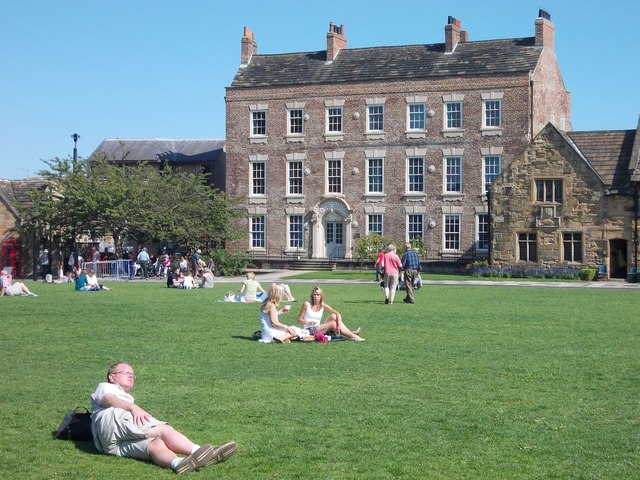
Co-Curate Page
Palace Green
- Overview About Palace Green Map Street View Palace Green is a grassed area immediately north of Durham Cathedral. The Green is surrounded by historic buildings, many associated with the Prince Bishops …
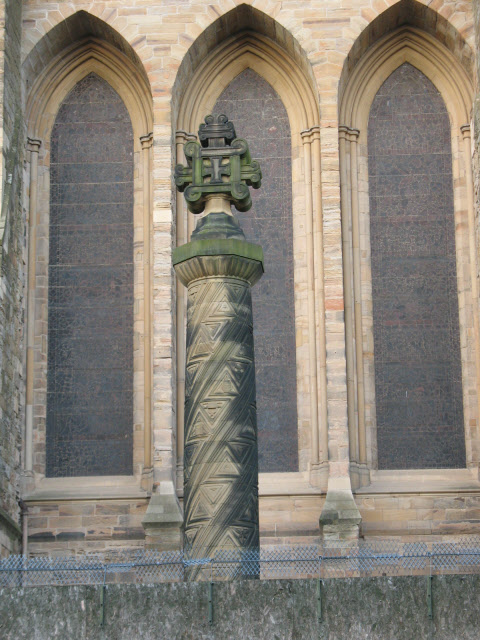
Co-Curate Page
WW1 Memorial Cross, Durham Cathedral
- Overview Map This memorial cross, by Palace Green on the east side of Durham Cathedral, commemorates those from County Durham lost in the First World War. The memorial, in the …

from Youtube (youtube)
Wedding of Lord Dunglass and Elizabeth Alington at Durham Cathedral (1936)
Pinned by Simon Cotterill

from Flickr (flickr)
Galilee Chapel, Durham Cathedral, Durham, Durham, England
Pinned by Simon Cotterill

from Flickr (flickr)
Galilee Chapel, Durham Cathedral, Durham, Durham, England
Pinned by Simon Cotterill

from Flickr (flickr)
Refectory Library and Great Kitchen, Durham Cathedral, Durham, Durham, England
Pinned by Simon Cotterill

from Flickr (flickr)
Galilee Chapel, Durham Cathedral, Durham, Durham, England
Pinned by Simon Cotterill


from Beamish (flickr)
German POWs being shown around Durham Cathedral, 1946
Pinned by Simon Cotterill

from Beamish (flickr)
German POWs giving presents at Durham Cathedral, 1946
Pinned by Simon Cotterill

from Flickr (flickr)
The Galilee Chapel, Durham Cathedral, Durham, England
Pinned by Simon Cotterill

from Flickr (flickr)
The Tomb of Bishop Richard Redman in Durham Cathedral
Pinned by Simon Cotterill

from Youtube (youtube)
Durham Cathedral: Readers choice for Britain's best building
Pinned by Simon Cotterill

from https://archive.org/details/r…
Rites of Durham, being a description or brief declaration of all the ancient monuments, rites, & customs belonging or being within the monastical church of Durham before the suppression
- A book written the first half of the sixteenth century giving a detailed account of Durham Cathedral as a Catholic institution, before the Reformation and its conversion to an Anglican …
Added by
Simon Cotterill

from https://archive.org/details/d…
Durham - Diocesan Histories
- by John Low, 1817-1888. Society for promoting Christian knowledge, London. Tract committee. Published 1881. Available as a free eBook.
Added by
Simon Cotterill

Co-Curate Page
Walter Skirlaw (d. 1406)
- Overview About Walter Skirlaw Walter Skirlaw was Bishop of Durham from 1388 until he died on 24th March 1406. Skirlaw was also a diplomat and advisor to King Richard II …

from Flickr (flickr)
Image taken from page 18 of 'A brief Sketch of Durham. Compiled for the use of the ... deputies of the ... Order of Odd-fellows ... attending the annual ... Committee of the Order held at D., etc. [With illustrations.]'
Pinned by Simon Cotterill

from Flickr (flickr)
Image taken from page 97 of 'Durham Cathedral ... Third edition, with plan and illustrations'
Pinned by Simon Cotterill

from Flickr (flickr)
[The cathedral and castle from the bridge, Durham, England] (LOC)
Pinned by Simon Cotterill

from Youtube (youtube)
Durham Cathedral County Durham : DJI Phantom 2 vision plus drone
Pinned by Simon Cotterill

Co-Curate Page
Palace Green
- Overview About Palace Green Map Street View Palace Green is a grassed area immediately north of Durham Cathedral. The Green is surrounded by historic buildings, many associated with the Prince Bishops …

Co-Curate Page
WW1 Memorial Cross, Durham Cathedral
- Overview Map This memorial cross, by Palace Green on the east side of Durham Cathedral, commemorates those from County Durham lost in the First World War. The memorial, in the …

from Youtube (youtube)
Wedding of Lord Dunglass and Elizabeth Alington at Durham Cathedral (1936)
Pinned by Simon Cotterill

from Flickr (flickr)
Galilee Chapel, Durham Cathedral, Durham, Durham, England
Pinned by Simon Cotterill

from Flickr (flickr)
Galilee Chapel, Durham Cathedral, Durham, Durham, England
Pinned by Simon Cotterill

from Flickr (flickr)
Refectory Library and Great Kitchen, Durham Cathedral, Durham, Durham, England
Pinned by Simon Cotterill

from Flickr (flickr)
Galilee Chapel, Durham Cathedral, Durham, Durham, England
Pinned by Simon Cotterill

